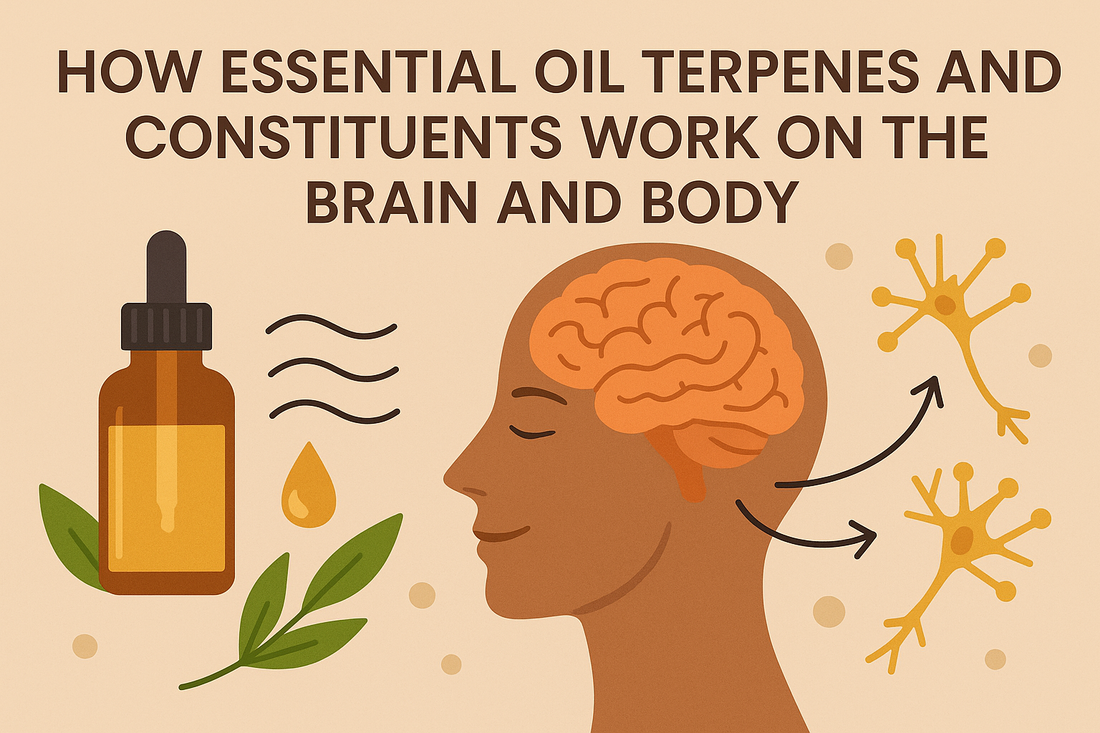
How Essential Oil Constituents Interact with the Brain, Body, and Nervous System: A Deeper Look at Terpenes and Receptors
Share
Essential oils are more than fragrant—they’re biochemically active substances that interact with the human body at a cellular and neurological level. Their impact is largely due to small, volatile molecules like terpenes, alcohols, ketones, and esters, which can cross biological membranes and bind to receptors throughout the body. These constituents influence the nervous, endocrine, immune, and integumentary (skin) systems, depending on their structure and route of exposure.
Terpenes and the Olfactory-Limbic Pathway
When essential oils are inhaled, their volatile molecules bind to olfactory receptors (ORs) in the nasal epithelium. These receptors are G-protein coupled receptors (GPCRs), which, when activated, trigger a cascade of intracellular signals leading to the olfactory bulb, and ultimately the limbic system—particularly the amygdala and hippocampus, centres for emotion and memory. This is why scent has such an immediate emotional effect, often before conscious awareness.
For example:
Linalool, found in lavender, activates GABA_A receptors in the brain, enhancing inhibitory signalling and promoting relaxation. It may also modulate glutamate receptors, reducing excitatory neurotransmission associated with anxiety and pain.
Limonene, present in citrus oils, has been shown to increase serotonin and dopamine levels in certain brain regions, contributing to mood-elevating effects.
Peripheral Receptors and the Nervous System
Topically applied essential oils can act on the peripheral nervous system, particularly on nociceptors (pain receptors) and thermoreceptors in the skin.
Menthol, from peppermint, activates TRPM8 receptors (transient receptor potential cation channel subfamily M member 8), which detect cold stimuli. This interaction produces a cooling sensation and inhibits pain signals.
Eugenol, found in clove oil, can inhibit voltage-gated sodium channels in sensory neurons, reducing pain signal transmission—similar in mechanism to local anaesthetics.
Additionally, compounds such as beta-caryophyllene, a sesquiterpene found in black pepper and copaiba, selectively bind to CB2 receptors of the endocannabinoid system. CB2 receptors are found primarily in immune tissues and peripheral nerves and play a role in reducing inflammation and modulating pain without affecting cognition or mood (as CB1 receptors do).
Influence on Neurotransmitters and Hormones
Several essential oil constituents influence neurotransmitter activity through direct or indirect mechanisms:
Alpha-pinene, from pine and fir oils, is a cholinesterase inhibitor, which enhances acetylcholine levels—supporting memory and cognitive function.
Lavender (linalool and linalyl acetate) influences 5-HT1A receptors (a subtype of serotonin receptor), promoting anxiolytic and antidepressant effects.
Oils rich in borneol, such as Douglas Fir, may enhance GABAergic transmission, aiding in calming the central nervous system.
Essential oils also influence the hypothalamic–pituitary–adrenal (HPA) axis. Inhalation of certain oils (e.g., frankincense or neroli) has been shown to reduce cortisol levels in saliva, suggesting a direct modulatory effect on stress hormone pathways.
Absorption and Systemic Circulation
Topically applied essential oils are absorbed transdermally due to their lipophilic nature. Once in the dermis, constituents can enter the bloodstream via capillaries and travel to target tissues. While the percentage absorbed systemically is small compared to pharmaceutical drugs, it is pharmacologically relevant—especially with repeated use or when applied over large areas.
For example, a 1% dilution of lavender oil applied to the skin can result in detectable plasma levels of linalool and linalyl acetate within 20–30 minutes. These molecules are metabolised in the liver and excreted in urine, primarily via glucuronidation.
Conclusion
Essential oils interact with a wide range of receptor systems—GABA, serotonin, dopamine, TRP channels, and even cannabinoid pathways. These interactions can influence the nervous system both centrally and peripherally, explaining the wide-reaching effects of aromatherapy on mood, stress, pain, and sleep. Understanding the pharmacology of these plant-based compounds allows for more targeted and respectful use of essential oils, especially when integrated into wellness and therapeutic practices.
